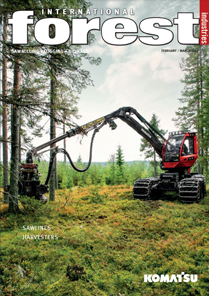EDITOR’S COMMENT Issue 87
The next phase
As many people are saying right now: the only thing certain is uncertainty. That is certainly true of forest industries at present.
That uncertainty has worked reasonably well for the forestry sector up until recently. Though you could never call it a linear progression, forestry markets have performed well since the nadir of all sectors in the 2008-2009 financial crisis.
As we commented at the time, primary sectors tend to be the first to bounce back following economic slumps, as consumers prioritise the essentials over the latest shiny new things. Raw materials, including timber, therefore performed increasingly well as we moved further into the previous decade, keeping forestry contractors busy and sawyers in need of new blades and better optimising technologies.
The strength of recovery in timber markets was also helped by forest industries’ sustainability credentials. The forest is an undisputed factory for renewable building products and fuels (if not emission free). It is worth harking back to the early 1990s at this point and the introduction of the Forest Stewardship Council and certification, without which the forestry sector may today find itself on the wrong side of the sustainability fence.
But leading into the pandemic, demand for sustainable products like wood was adding another tier of demand on top of already strong growth based on basic rising GDP numbers in key economies. COVID, then, initially crushed all sectors but as the world got moving again, constraints in some parts of the world in delivering wood stocks combined with a surge in DIY projects from suddenly grounded travellers meant a hike in timber prices. Timber was trading as high as $1,725 in the US at one point.
One would have through recent events such as the war in the Ukraine and the resulting sanctions on Russia would have pushed prices even higher, or at least maintained them as people resumed travel and the DIY demand eased off. But that’s not been the case.
At time of writing, timber was back at $573 – a drop of two thirds.
The reasons for this are fairly clear. China has continued to push for an unrealistic COVID-zero strategy that has meant its growth ambitions have taken a back seat. And inflation elsewhere as post-COVID stimulus packages bite – and the cost of fuel and food soar as a result of the war – have depressed global GDP forecasts.
The price volatility combined with supplychain disruption has meant builders are reluctant to commit to new projects for which they are now uncertain they can deliver. This has further dampened demand.
Ultimately, China will not sacrifice its growth indefinitely and the world will manage inflationary pressures. As that happens and GDP forecasts recover, timber will again be on the menu as a material of choice for the world.
But before that happens, we are in for a tricky little period. There’s no point pretending otherwise. Prices are down and inflation is up, which means so are costs for foresters – you don’t have to be an economist to figure out what that means for profits.
At times like these, those companies that invested heavily over the extended period of strength (now at an end) in technologies that improve productivity and efficiency, will be far more comfortable than those who pocketed all their profits and find themselves without any nuts for the winter.
Enjoy
Chris Cann




